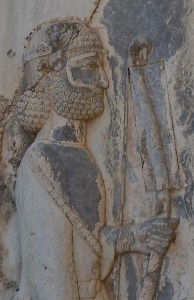Intaphrenes
Intaphrenes (Old Persian Vindafranâ): Persian courtier and general. Intaphrenes was one of the seven conspirators who killed the Magian usurper Gaumâta and helped Darius I the Great become king (September 522 BCE).

The most famous source of information about Intaphrenes' role in murder of the Magian is the second part of the third book of the Histories by the Greek researcher Herodotus of Halicarnassus (fifth century BCE). He tells us that
the Magian defended himself with his spear, and first he struck Aspathines in the thigh, and then Intaphrenes in the eye; and Intaphrenes lost his eye by reason of the wound, but his life he did not lose.note
That Intaphrenes was indeed involved in the killing of Gaumâta is confirmed by another source, the Behistun inscription; it also tells us the name of Intaphrenes' father, Vayaspâra.
Immediately after Darius' accession, several provinces of the Achaemenid empire revolted. The most important of these rebellions were the revolt of Babylon, which was led by king Nidintu-Bêl, and the revolt of Media under king Phraortes. Darius personally suppressed the Babylonian rebellion in December, and left the war against the Medes to his generals Hydarnes and Hystaspes, who were able to isolate the Median rebellion. In January 521, Darius left Babylon with a large army; he defeated the Medes on 8 May.
When Darius was away, the Babylonians revolted again; their king was Arakha, whose throne name was Nebuchadnezzar IV . What happened next, we read in the Behistun inscription.
King Darius says: Then did I send an army unto Babylon. A Persian named Intaphrenes, my servant, I appointed as their leader, and thus I spoke unto them: "Go, smite that Babylonian host which does not acknowledge me."
Then Intaphrenes marched with the army unto Babylon. Ahuramazda brought me help; by the grace of Ahuramazda did Intaphrenes overthrow the Babylonians and brought over the people unto me. Of the twenty-second day of the month Markâsanaš they seized that Arakha who called himself Nebuchadnezzar, and the men who were his chief followers.
Then I made a decree, saying: "Let that Arakha and the men who were his chief followers be crucified in Babylon!"
This battle took place on 27 November 521 BCE. The Behistun inscription is a very stereotypical text. All wars are described in the same words. This war, however, is an exception; where we usually read "by the grace of Ahuramazda did my army utterly overthrow that rebel host", we now read "by the grace of Ahuramazda did Intaphrenes overthrow the Babylonians".
It is not clear what this means, if it is significant at all. (It may be a scribal error.) But it is possible that Darius does not say "my army" because the army under command of Intaphrenes was not the king's army. It may have been recruited by Intaphrenes himself.
When Darius' rule was well-established, he ordered the Behistun inscription to be made, in which the new king celebrated his victories. On the relief, we see Darius, his bow carrier Intaphrenes (see picture), the king's lance carrier Gobryas, and his defeated enemies. Intaphrenes was, in other words, one of the most influential men in the Achaemenid empire. It is possible that he was second to the king only: in the Behistun relief he comes behind the king and before Gobryas. It is also possible that the function of bow carrier was created especially for Intaphrenes; we know no names of earlier bow carriers.
Herodotus has more to tell about Intaphrenes. In book three of the Histories, he writes:
Soon after the rising of the seven Persians against the Magian, one of their number, Intaphrenes, was executed for a failure to show proper respect for the king's authority.
Having business to transact with Darius, he wished to enter the palace. Now it had already been agreed that any of the conspirators might visit the king unannounced, provided that he was not, at the moment, in bed with a woman; and in view of this Intaphrenes refused to have his name sent in by a messenger, and claimed it as his right, as one of the seven, to walk straight in. He was, however, stopped by the king's chamberlain and the sentry on duty at the palace gate, who told him that Darius had, in fact, a woman with him at the time. Thinking this was only a trumped-up excuse to keep him out, Intaphrenes drew his scimitar and cut off their ears and noses, strung them on his horse's bridle, tied the bridle around their necks, and sent them packing.
The poor fellows showed themselves to Darius and explained the reason for their plight, which at once suggested to the king the alarming possibility of a fresh conspiracy. Thinking his six former confederates might all be in this business together, he sent for each of them in turn, and sounded them to see if they approved of what Intaphrenes had done. None of them did; so as soon as he was satisfied that Intaphrenes had acted entirely on his own initiative, he had him arrested together with his children and all his near relations, in the strong suspicion that he and his family were about to raise a revolt. All the prisoners were then chained, as condemned criminals.note
Herodotus continues his narrative with a story about Intaphrenes' wife, who manages to secure a pardon for her brother, and concludes:
The rest of the family were all put to death. This then, was the early end of one of the seven confederates.
This story is certainly plausible, but there may be more to it. Intaphrenes was a very powerful man: the king's bow carrier, possibly the second man in the empire, able to recruit an army of his own. It may be that Darius seized the opportunity to get rid of someone who had come too close to the throne. He could now start to reign as a real autocrat.